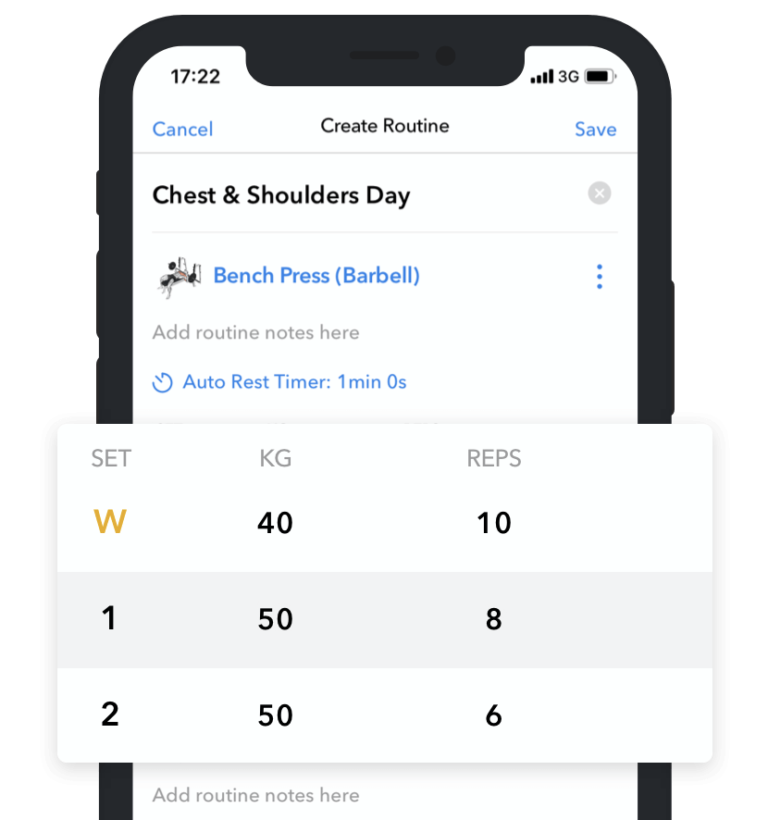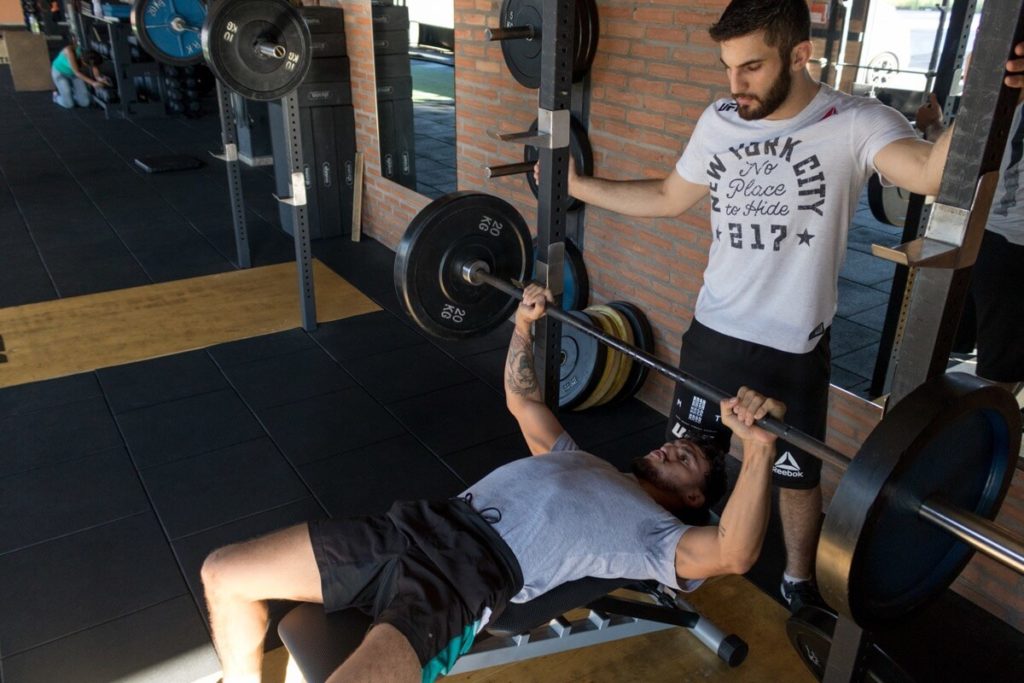PR, short for a personal record, is any milestone you achieve in your training, whether by lifting more weight, doing more reps at a given intensity, or beating your previous best performance in some way.
A popular example of a PR is setting a new 1-rep max (1RM) on a compound exercise. The first time you lift a specific weight for a single is a new 1RM and PR. Of course, PRs are not strictly limited to setting new 1RMs, as progress can occur in many ways, which we will discuss below.
A PR workout is any gym session where you set a new personal record on one or more exercises.
Setting PRs is necessary for staying motivated, proving to yourself that your workout plan works, and improving your physical capacity.
Let’s dig into the topic to explore the science of PRs, their importance, and how to set them safely and effectively.
The Science of PRs
When a person first starts weight training, almost any type of workout delivers results (building muscle, gaining strength, etc.). But unfortunately, that doesn’t go on forever because the body adapts to a specific level of neuromuscular stress.
The more you perform a specific workout, the less effective it becomes because your body adapts fully and has no reason to improve further.
Your first bench pressing session will be disruptive enough to force progress, even if you only use an empty bar. However, using the same weight and doing the same number of reps stops being as disruptive, causing progress to plateau.
Striving to set new gym PRs is necessary for ongoing progress because you force your body to adapt to an increasingly greater stressor (1).
For example, if you use a certain weight on the bench press now, you should lift a heavier load down the road to ensure you provide a substantial enough disruption to grow further.
How you structure your training program and what personal records you choose to pursue will largely depend on your training goals. For example, someone interested in building strength might only focus on lifting the heaviest weight for 2-6 reps. In contrast, trainees wanting to build muscle should also consider the previous maximum reps they’ve done and strive to increase the number.
Picking the correct training goals and progression methods falls outside the scope of this article, but one thing is clear:
Setting new personal records in your training regularly is necessary for ongoing progress.
A Common Misconception About Personal Records
Prevailing wisdom suggests that a one-rep max is the only gym PR that matters, which is false.
Knowing your actual one-rep max can be motivating, but fixating on that number is useless for people who don’t compete in strength sports, such as powerlifting.
Factors like excitability (e.g., comparing a competition PR to a gym PR), range of motion, and compensatory movement patterns (e.g., using momentum, hitching, etc.) can influence how much weight you can lift for one rep at any time.
For most trainees looking to build muscle and get stronger, 3-, 5-, and even 8-rep maxes will be more valuable and safer to track.
Higher-rep maxes provide more valuable data because they are better indicators of muscle growth and strength gain. It’s more challenging to ‘cheat’ your way to lift more weight, and the risks are far smaller because you’re using more manageable loads.
If you’re an average trainee looking to get fit and want to track your progress on your bench press, squat, and other movements, consider testing in higher rep ranges: 3 to 5, 5 to 8, or even 10 to 15.

Hevy – Workout Tracker





Hevy – Workout Tracker
Create and log your pr workout with Hevy and track your progress
Tips on Setting PRs in a Safe and Effective Way
1. Test Less Frequently
One of the biggest errors trainees make is constantly chasing PRs, especially on their one-rep max. For instance, if you lifted 135 lbs for a single during your previous workout, you must do at least 140 lbs in your next session.
There are several issues with such an approach, but perhaps the biggest one relates to mindset. People see personal records, or at least PR attempts, as part of any training session.
In reality, a personal record results from intelligent and consistent training. Therefore, you must train hard for weeks and give your body time to adapt before testing how much actual progress you’ve made.
Lifting the heaviest weight possible means putting yourself at risk of training with poor form, over-stressing your joints and connective tissues, and accumulating unnecessary neural fatigue (central nervous system fatigue that affects muscle contractions and performance) (2, 3).
Our first tip for setting PRs is to ditch the idea of maxing out on a given exercise every week or session. Train with sub-maximal loads and do several reps per set, leaving one to three reps in the tank on most of your sets.
Build up your 1RM and test it out every 8 to 12 weeks. If you must attempt to set new records, do so by using 70 to 85 percent of your 1RM and doing the maximum number of reps you can during scheduled AMRAP (as many reps as possible) sets.
2. Have a Spotter


Whenever you decide to test your 1, 3, or even 5+ RM, especially on squats, bench presses, and such, have someone there to spot you. Some people feel embarrassed to ask for assistance at the gym, but PR attempts can be dangerous. If you cannot do it alone, having someone there to help you complete a rep can save you from potential trauma.
3. Pick The Load Carefully
Deciding what weight to attempt can be challenging, especially if you want to test your 1RM. For example, how do you know what’s a realistic attempt for a single if you’ve only done sets of 5+ reps in the past two months?
One handy option is to use a 1RM calculator. It asks you to write how much weight you can lift and for how many reps to estimate your max. For instance, if you input 135 lbs for 5 reps, it estimates your 1RM at 152 lbs, which gives you a target for testing.
4. Examine Your Form
A lifter’s technique often changes as they add more weight to the bar. You might have textbook squatting form at 60 percent of your 1RM, but that may change as you lift 80, 90, or 95+ percent of your max.
Because of that, it’s crucial to examine your form in some way, especially on 1RM attempts and AMRAP sets. For instance, record your most challenging set to see how your technique looks from the side.
You might think you’re doing it perfectly, but a simple video can reveal subtle or glaring errors.
For example, you might have the tendency to cut your squat depth as you get closer to 90-95 percent of your 1RM. Or maybe a muscle imbalance or immobility causes you to shift slightly to one side.
Alternatively, have your coach there and ask them for feedback. Specifically, ask if you’re starting to make mistakes as the weight increases.
How to Incorporate PRs into Your Workout Routine
As discussed in a previous point, one common mistake trainees make is to attempt a new personal record too frequently, which can lead to technique breakdown, a higher injury risk, and burnout.
You should attempt to set a new PR after at least eight weeks of solid training. Putting in the work promotes adaptations, resulting in better performance.
While there is no single best way to set a new PR on a particular lift, there are some general guidelines to consider:
1. The Personal Record Attempt Should Align with Your Training
The first idea is relatively straightforward but still worth discussing because there is often a mismatch between trainees’ regular training and their PR aspirations.
An example would be someone doing a traditional hypertrophy plan and testing their 1 RM on the big three (squat, bench press, and deadlift).
The problem is a muscle-building plan isn’t ideal for improving your one-rep maxes and lifting the most weight for a single rep doesn’t lead to more hypertrophy (4). In other words, the two aren’t related.
Therefore, you should align your PR attempts with your training plan. If you follow a strength program and primarily care about your one rep max, by all means, do 1RM attempts safely and intelligently.
But, if you follow a program primarily designed for hypertrophy, endurance, or another outcome, attempt new records related to that: doing more reps with the same weight, completing the same amount of volume in less time, etc.
2. Follow a Natural Progression Pattern
A PR attempt should be a natural extension of your training plan and should occur as the next step. Doing so means you’ve given your body enough time to prepare for that type of stress.
For example, let’s say you want to test your one rep max eight weeks from now. Progression for a particular exercise could look like so:
Week 1 – 3×8 (3 sets, 8 reps)
Week 2 – 4×7
Week 3 – 5×6
Week 4 – 5×5
Week 5 – 5×4
Week 6 – 5×3
Week 7 – 6×3 (lighter load to dissipate some of the build-up fatigue; RPE of 7-7.5)
Week 8 – 1RM attempt
Here’s another example, this time within the context of a hypertrophy plan. We won’t be testing 1RMs here. Instead, we will do an 8-rep max, gradually increasing the rate of perceived exertion (RPE).
Week 1 – average RPE 6.5-7
Week 2 – average RPE 7-7.5
Week 3 – average RPE 7.5-8
Week 4 – average RPE 8-8.5
Week 5 – average RPE 8.5-9
Week 6 – deload week as a form of tapering to recover and promote supercompensation
Week 7 – 8-rep max attempt
Hevy allows you to effortlessly track your RPE from set to set.
3. Recover Beforehand
Setting a new personal record depends on optimizing your training, nutrition, and recovery, allowing you to peak at a specific time.


Work up to a PR attempt but give your body time to recover before your all-out sets. Take great care of your sleep, eat enough calories and protein, and include a brief taper (a period of less challenging training before competition or, in our case, a PR) to ensure optimal performance.
If things don’t go according to your plans and you feel tired on the day you’re supposed to test yourself, re-schedule. There is no point in trying to set a PR if your body isn’t up for the challenge because you will generate fatigue, mess up your training plan, and likely miss the target.
Conclusion
Setting a new PR can be incredibly motivating and fulfilling. Achieving a new personal best signifies that you’re doing the right things and encourages you to keep pushing forward.
With that said, PRs take time to occur, and attempting them too frequently can do more harm than good. Because of that, focus on your regular training most of the time. Aim for small progress, be consistent, prioritize proper technique, and take good care of your recovery.
Most importantly, listen to your body to determine the best time to attempt a new PR, and don’t be afraid to re-schedule if you don’t feel you can perform at your best.





Hevy – Workout Tracker





Hevy – Workout Tracker
Create and log your pr workout with Hevy and track your progress
Check out Hevy if you’re looking for a simple app to organize your workouts and keep track of your performance.
FAQs
1. What does PR mean in gym training?
A PR stands for personal record and signifies a new milestone in your training performance.
2. How often should you attempt to set new PRs?
It mostly comes down to the specific PR you want to set, but every 8 to 12 weeks is a good mark for most people.
3. Is a PR one rep?
A PR can be one rep, also known as one-rep max or a 1RM, but it isn’t limited to that. Any new milestone in your training (max reps with specific weight, mastering a new exercise, etc.) can be classified as a personal record.




